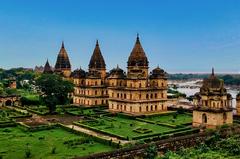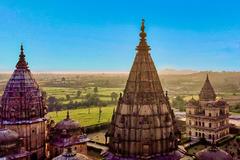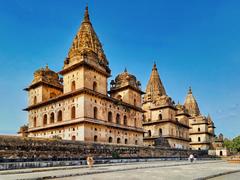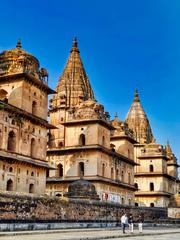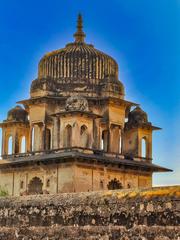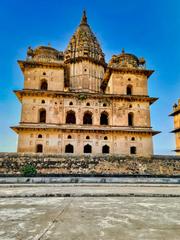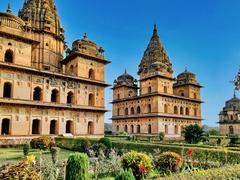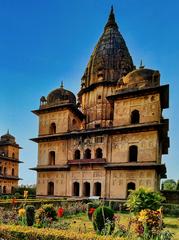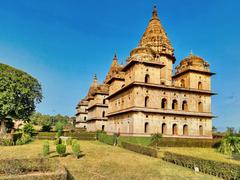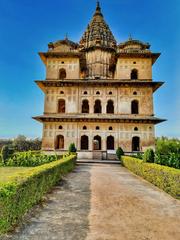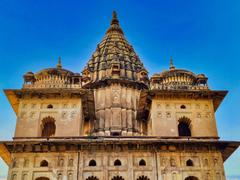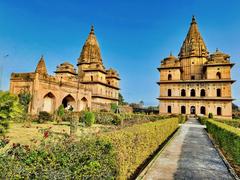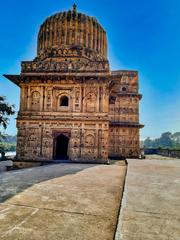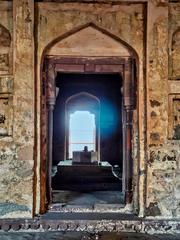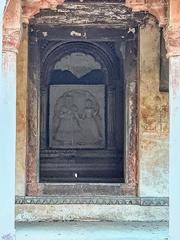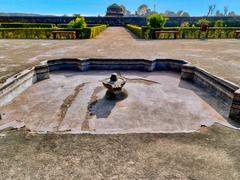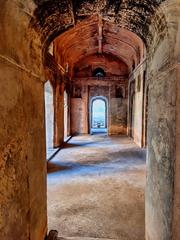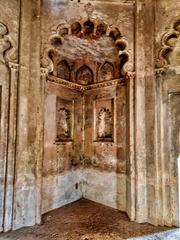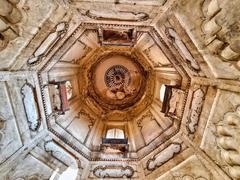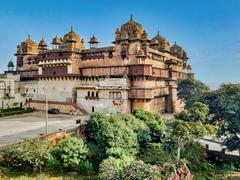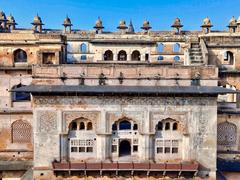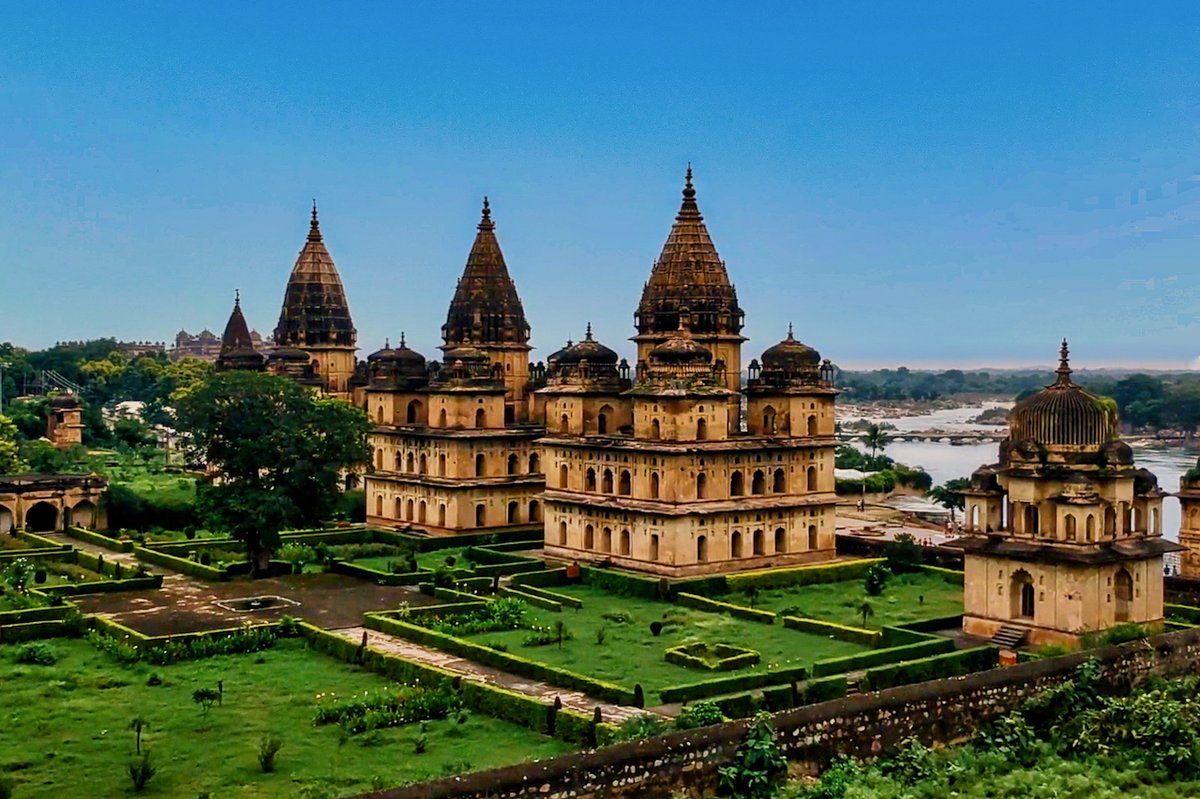
Orchha Chhatris: Visiting Hours, Tickets, and a Comprehensive Guide to Historical Sites in Orchha, Bundelkhand
Date: 14/06/2025
Introduction
Nestled on the tranquil banks of the Betwa River in Madhya Pradesh, the Orchha Chhatris stand as enduring symbols of Bundelkhand’s royal heritage. These 14 magnificent cenotaphs, built to commemorate the Bundela dynasty rulers, offer a compelling blend of Rajput and Mughal architectural styles, set amidst a serene riverside landscape. This guide provides detailed information on the Orchha Chhatris’ history, architectural highlights, visiting hours, ticketing, accessibility, and practical travel tips, ensuring an enriching and respectful visit to one of India’s most evocative historical sites.
Historical Context: The Bundela Dynasty and Orchha’s Legacy
The history of Orchha is inseparable from the Bundela dynasty, a prominent Rajput lineage that ruled Bundelkhand from the 16th to the 18th centuries. According to legend, the dynasty’s founder was a Rajput prince who survived a sacrificial ritual and was named “Bundela,” meaning “one who offered blood” (Orchha Resort). After the loss of their early capital at Garhkurar, the Bundelas established Orchha in 1531 under Raja Rudra Pratap Singh, strategically selecting a hidden location along the Betwa River for its natural defenses (Academia Indica).
Orchha flourished into a political and cultural center, especially under Raja Bir Singh Deo (reigned 1605–1627), whose alliance with Mughal prince Salim (Emperor Jahangir) brought Orchha autonomy and prosperity. The era witnessed the construction of architectural marvels, including the Jehangir Mahal and Raja Mahal, blending Rajput aesthetics with Mughal influences (Madhya Pradesh Tourism; India Travel).
The Orchha Chhatris: Royal Cenotaphs on the Betwa
Memorial Purpose and Symbolism
The Orchha Chhatris were constructed as cenotaphs to honor deceased Bundela rulers and their family members. Unlike tombs, these structures serve as memorials at the sites of royal cremations, symbolizing the valor, legacy, and spiritual significance of the Bundela dynasty (MakeMyTrip). Key chhatris are dedicated to rulers such as Vir Singh Deo, Madhukar Shah, and Jaswant Singh, each marked by unique inscriptions and architectural details.
Architectural Highlights
The chhatris exhibit a harmonious fusion of Rajput and Mughal architectural styles:
- Structural Design: Typically three-storied, with square or octagonal bases, domed roofs, and intricately carved pillars.
- Panchayatan Layout: Central domed chambers surrounded by four smaller domes at each corner, emphasizing symmetry and spiritual geometry.
- Mughal Influences: Bulbous domes, arched entrances, and ornamental jali (lattice) screens are prominent, reflecting the Bundelas’ cultural connections with the Mughal court (IJSSR).
- Decorative Elements: Subtle yet refined carvings, cornices, and remnants of frescoes and murals inside some cenotaphs.
The placement of the chhatris along the Betwa River is both practical and symbolic, as the river is considered sacred and its reflective waters enhance the site’s spiritual aura (Ravenous Legs).
Visiting Orchha Chhatris: Hours, Tickets, and Access
Visiting Hours
The Orchha Chhatris are open daily from 7:00 AM to 6:00 PM. Early mornings and late afternoons are ideal for photography and avoiding the midday heat.
Ticket Prices
- Indian Nationals: ₹25 per person
- Foreign Tourists: ₹300 per person
- Children under 15: Free
Tickets are available at the entrance. Online booking is not yet available, so plan to arrive early during peak seasons (Holidify).
Location and Accessibility
Located near Kanchan Ghat, about 3 km from Orchha’s town center, the chhatris are easily accessible on foot, by bicycle, or via auto-rickshaw from most accommodations. The nearest railway station is Jhansi Junction (16 km away), with taxis and auto-rickshaws connecting to Orchha (Tripoto).
Site Navigation and Facilities
The chhatris are arranged in a linear cluster along the Betwa’s southern bank, surrounded by gardens and walking paths. Facilities include public restrooms, benches, and small kiosks for snacks and bottled water. The site is pedestrian-friendly, but some cenotaphs have steep stairs and uneven surfaces—wear sturdy footwear and exercise caution.
Guided Tours and Visitor Experience
Hiring a local guide is highly recommended for deeper insights into the historical and architectural significance of each cenotaph. Guides can be arranged at the entrance or through hotels and local tour operators. Informative signboards in Hindi and English provide context, but a guide’s storytelling adds richness to the visit (UNESCO).
Visitors can expect a tranquil, contemplative atmosphere, especially during quiet hours. The gardens and riverside setting offer ample opportunities for photography, sketching, and relaxation.
Best Time to Visit
October to March is the most pleasant season, with cool temperatures (9°C to 25°C) and clear skies. The monsoon (July–September) brings lush greenery but can cause slippery paths and unpredictable showers. Summers (April–June) are very hot and less comfortable for sightseeing (TravelSetu).
Cultural Etiquette and Accessibility
- Dress modestly and respect the site’s sacred status.
- Avoid loud noise and littering.
- Some cenotaphs require stair climbing; main pathways are accessible but not fully wheelchair-friendly.
- Remove footwear when entering interiors if requested.
- Photography is allowed, but drone use requires special permission.
Unique Experiences and Events
- Sunrise and Sunset Views: Capture the chhatris glowing in golden light, with the river providing dramatic reflections (Tale of 2 Backpackers).
- River Activities: Rafting and kayaking on the Betwa offer unique perspectives of the chhatris (Kingdom of Travelers).
- Cultural Festivals: Local festivals, such as Ram Navami and Bundela Mahotsav, feature music, dance, and rituals at the chhatris.
Nearby Attractions
- Orchha Fort Complex: Encompassing Jehangir Mahal, Raja Mahal, and Sheesh Mahal.
- Ram Raja Temple: Unique for its palace-temple fusion architecture.
- Chaturbhuj Temple: Known for its towering spire and panoramic town views.
- Laxmi Narayan Temple: Celebrated for murals and architectural blend.
- Phool Bagh: A historic garden for relaxation (TravelSetu).
Preservation and UNESCO Prospects
The Orchha Chhatris, along with other town monuments, are under consideration for UNESCO World Heritage status, which would enhance conservation and sustainable tourism efforts (Travel and Tour World). Restoration projects are ongoing, led by the Archaeological Survey of India.
Practical Tips for Visitors
- Visit early in the day for the best light and fewer crowds.
- Carry water, sunscreen, and a hat.
- Allocate at least 1–2 hours to explore the site and nearby attractions.
- Check local event calendars for festivals or special ceremonies.
- Combine your chhatris visit with a tour of the Orchha Fort Complex for a comprehensive experience.
Frequently Asked Questions (FAQ)
Q: What are the Orchha Chhatris visiting hours?
A: 7:00 AM to 6:00 PM daily.
Q: How much are tickets for the Orchha Chhatris?
A: ₹25 for Indian nationals, ₹300 for foreign tourists, children under 15 free.
Q: Can I buy tickets online?
A: Currently, tickets are only available onsite.
Q: Are guided tours available?
A: Yes, local guides can be hired at the entrance or through hotels.
Q: Is the site accessible for wheelchairs?
A: Main pathways offer limited accessibility; some cenotaphs require stair climbing.
Q: Is photography allowed?
A: Yes, photography is permitted; drones require special permission.
Q: What is the best time to visit?
A: October to March, especially at sunrise or sunset.
Conclusion
The Orchha Chhatris stand as poignant reminders of Bundelkhand’s regal past, offering visitors a unique blend of history, architecture, and natural beauty. A visit to these cenotaphs, set against the backdrop of the Betwa River, is a journey into India’s royal heritage—one that rewards reflection, discovery, and a deeper appreciation for the region’s enduring cultural identity.
For the most up-to-date information, travel tips, and inspiration, consult official tourism resources such as Madhya Pradesh Tourism, explore user-friendly guides on Holidify, and consider downloading the Audiala app for enhanced travel planning. Share your experiences and connect with other travelers to keep the legacy of Orchha alive for generations to come.
